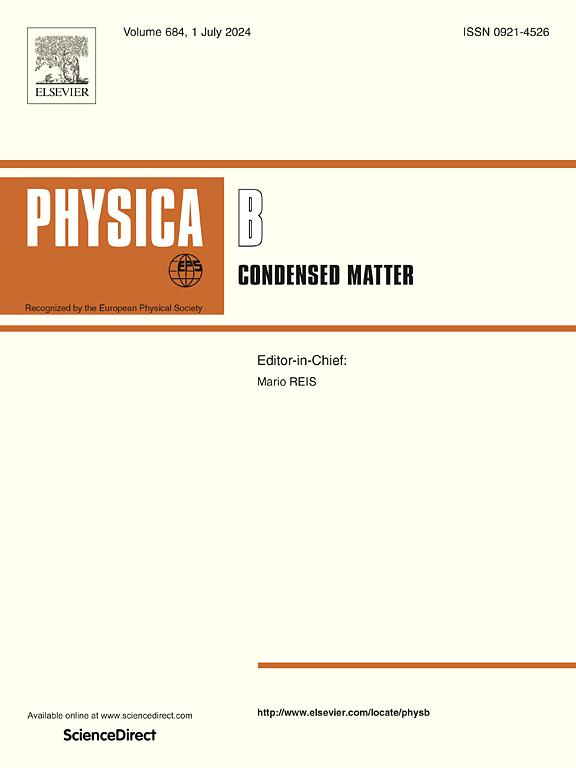用于紫外线屏蔽应用的 La2W2O9/Fe2O3 复合材料的结构、形态和光学特性
IF 2.8
3区 物理与天体物理
Q2 PHYSICS, CONDENSED MATTER
引用次数: 0
摘要
目前,人们已经对单个氧化物 La2W2O9 和 Fe2O3 进行了研究,但尚未对其复合形式进行研究。利用固态反应技术,我们制造出了 La2W2O9/Fe2O3 复合材料。在特定的煅烧循环中,混合了原材料前驱体。扫描电子显微镜(SEM)用于研究形态微观结构,X 射线衍射(XRD)用于研究结构特征。通过差热分析(DTA)和热重分析(TGA)研究了热和重力特性。通过紫外-可见光谱分析了光学特性,包括透射率、吸光度、吸收系数、带隙(Eg)、穿透深度(β)、厄巴赫能(EU)、折射率、光导率和介电函数。这些研究结果表明,与纯 La2W2O9 相比,加入 Fe2O3 后光学特性得到改善。La2W2O9/Fe2O3 复合材料有望在防晒产品、紫外线屏蔽或太阳能过滤等领域得到应用。本文章由计算机程序翻译,如有差异,请以英文原文为准。
Structural, morphological and optical properties of the La2W2O9/Fe2O3 composite for UV-shielding applications
Currently, research has been conducted on the individual oxides La2W2O9 and Fe2O3 but not on its composite form. Using a solid-state reaction technique, a La2W2O9/Fe2O3 composite was created. A particular calcination cycle was followed by mixing the raw precursors. Scanning electron microscopy (SEM) was used to investigate the morphological microstructure, and X-ray diffraction (XRD) was used to examine the structural characteristics. The thermal and gravimetric properties were examined via differential thermal analysis (DTA) and thermogravimetric analysis (TGA). The optical characteristics were investigated via UV–visible spectroscopy, which investigated included the transmittance, absorbance, absorption coefficient, band gap (Eg), penetration depth (β), Urbach energy (EU), refractive index, optical conductivity, and dielectric function. These findings indicate that the optical properties improved after the addition of Fe2O3 compared with those of pure La2W2O9. The La2W2O9/Fe2O3 composite holds promise as a prospective material for use in the fields of sunscreen products, UV shielding or solar filtration.
求助全文
通过发布文献求助,成功后即可免费获取论文全文。
去求助
来源期刊

Physica B-condensed Matter
物理-物理:凝聚态物理
CiteScore
4.90
自引率
7.10%
发文量
703
审稿时长
44 days
期刊介绍:
Physica B: Condensed Matter comprises all condensed matter and material physics that involve theoretical, computational and experimental work.
Papers should contain further developments and a proper discussion on the physics of experimental or theoretical results in one of the following areas:
-Magnetism
-Materials physics
-Nanostructures and nanomaterials
-Optics and optical materials
-Quantum materials
-Semiconductors
-Strongly correlated systems
-Superconductivity
-Surfaces and interfaces
 求助内容:
求助内容: 应助结果提醒方式:
应助结果提醒方式:


